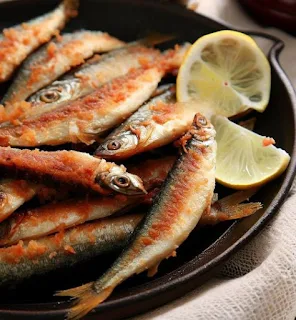Fried Sardines with Purée Chermoula Sauce
Mediterranean sea sardines are a culinary staple in North Africa. Sardines have a strong flavor and raisin chermoula sauce pairs perfectly.
For generations, fishermen have been throwing their nets into the Mediterranean Sea to catch sardines. The Mediterranean Sea spans 46,000km or 28,600 miles across 21 countries and is considered one of the last remaining great fisheries in the world to catch sardines.
Sardines became a culinary staple in North Africa due to a combination of factors. Firstly, sardines are abundant in the Mediterranean Sea, and North African countries have a long history of fishing and seafood cuisine, making them a natural choice for inclusion in local diets.
North African cuisine also tends to favor bold and flavorful spices and herbs, which complement the strong flavor of sardines. Sardines are often grilled, fried, or baked with herbs and spices such as cumin, paprika, garlic, and cilantro, creating a delicious and distinctive taste.
The combination of abundance, affordability, flavor, and nutrition has helped to establish sardines as a beloved culinary staple in North African cuisine.
Six traditional sardine dishes popular in North Africa.
To clean sardines, first rinse them under cold running water to remove any loose scales or debris. Then, use a sharp knife to make a shallow cut along the belly of the fish from the head to the tail, being careful not to cut too deeply into the guts. Next, use your fingers or a small spoon to remove the guts, along with the head and tail, if desired. Finally, rinse the fish thoroughly inside and out under cold running water and pat them dry with paper towels before cooking. Some people also like to remove the backbone by gently pulling it out with their fingers or cutting it out with scissors, but this is optional.
Fried Sardines with Purée Chermoula Sauce Recipe.
For a more flavorful dish, marinate the sardines in the chermoula for at least 2 hours, or up to overnight.
Ingredients
1 pound fresh sardines, gutted and scaled
1 cup chermoula, recipe below
1/4 cup all-purpose flour
1 large chicken egg, beaten
1/2 cup bread crumbs
1/4 cup olive oil
Salt and pepper to taste
Directions
Preheat oven to 400 degrees F (200 degrees C). In a large bowl, combine the sardines and chermoula. Mix well to coat the sardines. In a shallow dish, combine the flour, egg, and bread crumbs. Season with salt and pepper. Dredge the sardines in the flour mixture, then dip them in the egg mixture. Finally, coat them in the bread crumb mixture. Heat the olive oil in a large skillet over medium heat. Fry the sardines in the hot oil for 2-3 minutes per side, or until golden brown and cooked through. Serve immediately with Chermoula sauce.
Chermoula, a North African spice mixture, adds a flavorful kick to sardines and can also be used as a marinade for meat. If you don't have chermoula, you can make your own. Chermoula is a marinade and relish used in Algerian, Libyan, Moroccan and Tunisian cooking. It is traditionally used to flavor fish or seafood, but it can be used on other meats or vegetables. It is somewhat similar to Latin American chimichurri.
Simply combine the following ingredients and follow the directions.
Dried Raisin Purée Chermoula Sauce
Ingredients
1/4 cup olive oil
1/4 cup lemon juice
1/4 cup chopped cilantro
1/4 cup chopped parsley
2 cloves garlic, minced
1 teaspoon ground cumin
1/2 teaspoon paprika
1/4 teaspoon salt
1/4 teaspoon black pepper
1/4 cup dried dark raisin purée
1/2 onion, chopped
2 whole cloves
1/2 teaspoon chili powder
1/4 teaspoon cinnamon
Directions
In a large bowl, combine the olive oil, lemon juice, cilantro, parsley, garlic, cumin, paprika, salt, and pepper. Stir in the dried dark raisin purée, onion, cloves, chili powder, and cinnamon. Mix well to combine. Cover and refrigerate for at least 30 minutes, or up to overnight. Use as a marinade for fish, seafood, chicken, or meat. You can also use it as a relish or sauce. Chermoula can be added to soups, stews, and tagines. It can also be used as a dip for vegetables or bread. Chermoula is somewhat similar to Latin American chimichurri.
Sardines have a deep cultural and historical significance in North African cuisine, representing not only a source of food and nutrition but also a symbol of tradition, celebration, and economic prosperity.
Sardines have a rich cultural and historical significance in North African cuisine. They have been a staple of the diet in North Africa for centuries due to their abundance in the Mediterranean Sea and the coastal regions of North Africa. North African countries such as Morocco, Algeria, Tunisia, and Libya have a long history of fishing and seafood cuisine, and sardines have played an important role in their culinary traditions.
In Morocco, sardines are considered a national dish and are an essential part of the country's food culture. Sardines are often grilled or fried and served with a variety of accompaniments, such as bread, olives, and lemon wedges. In Tunisia, sardines are often preserved in olive oil or vinegar and served as a snack or appetizer.
Sardines are also an important part of the cultural and social traditions of North Africa. In Morocco, for example, the annual sardine festival in the coastal town of Essaouira is a celebration of the sardine harvest and includes music, dancing, and a variety of sardine-based dishes.
More recipes you will find delicious.
- African Mexican Salsa

- Learn how to cook buttermilk fried yams

-
Recipe of peppered goat

- San Pedro African Seafood Recipe

-
Nigerian Breakfast Fried Akara and Ogi







